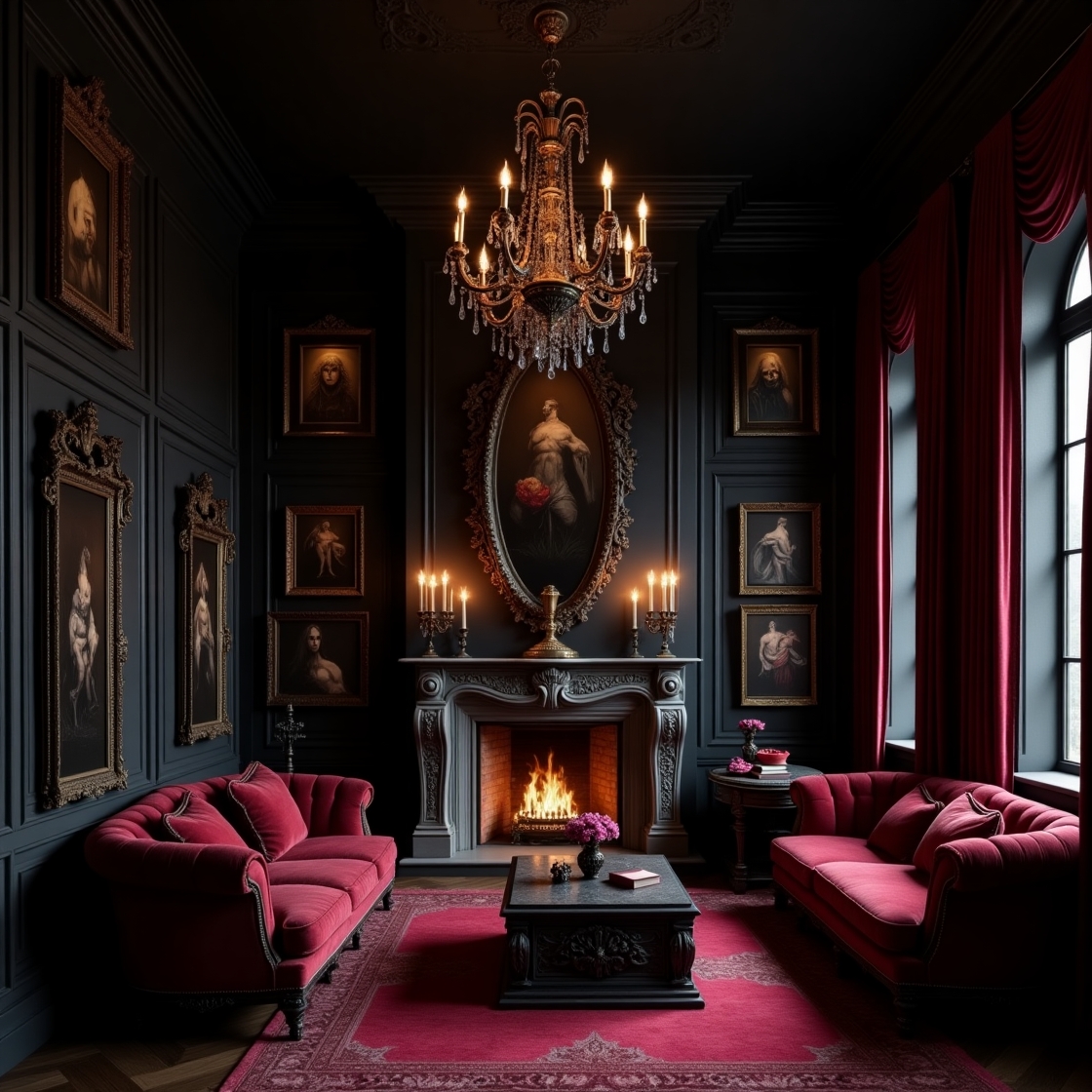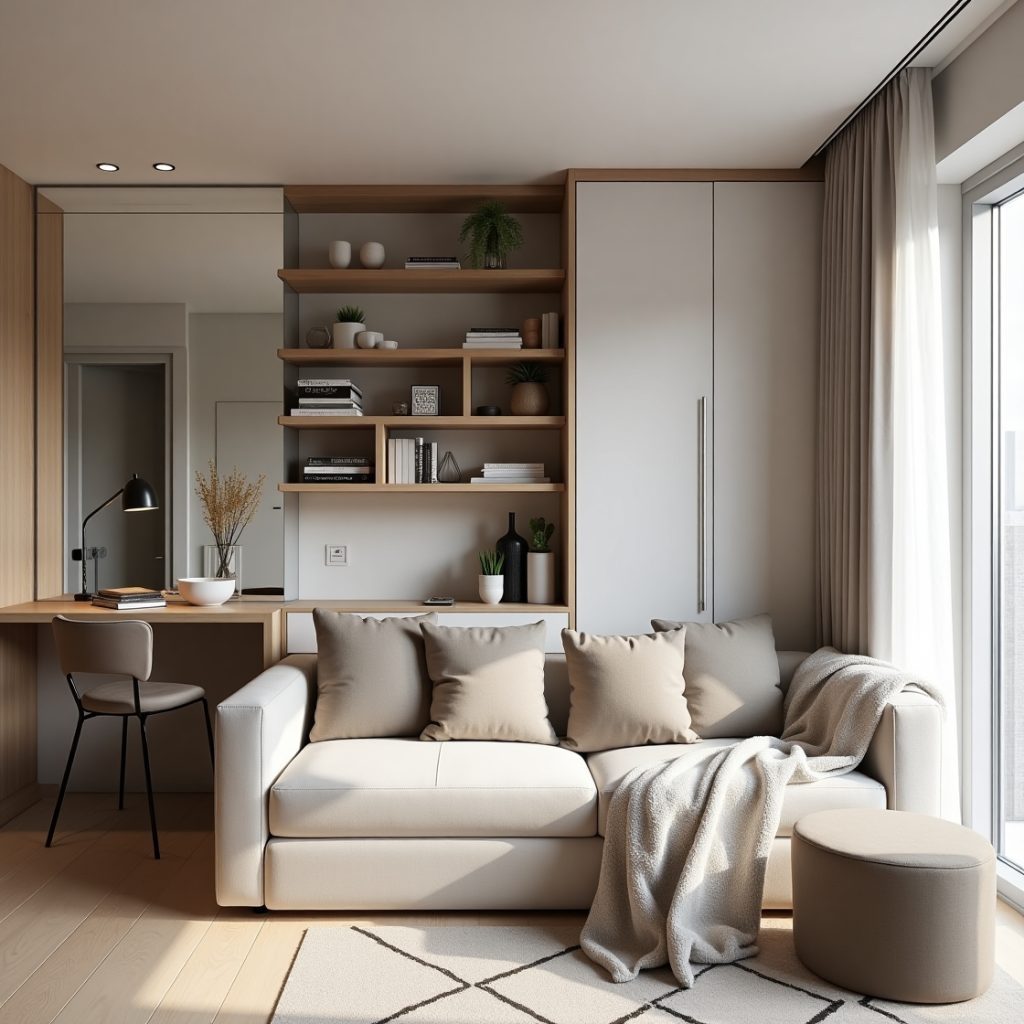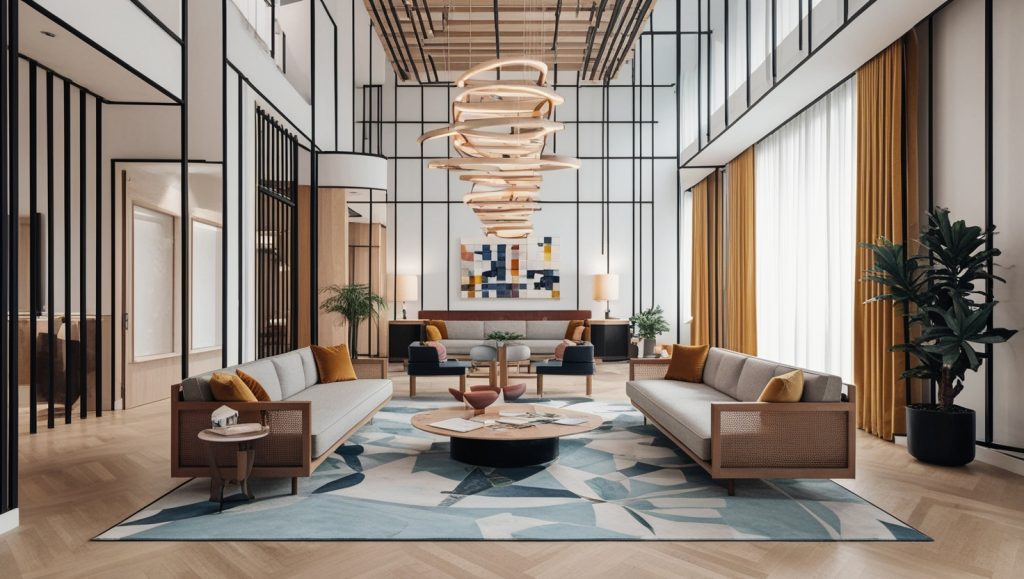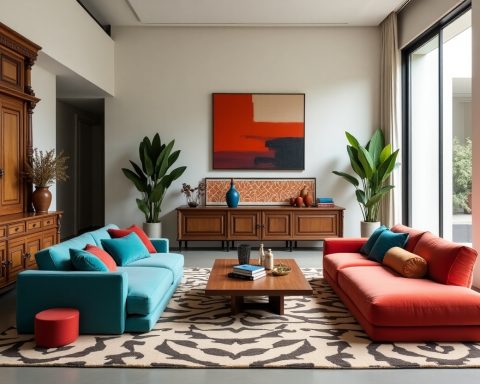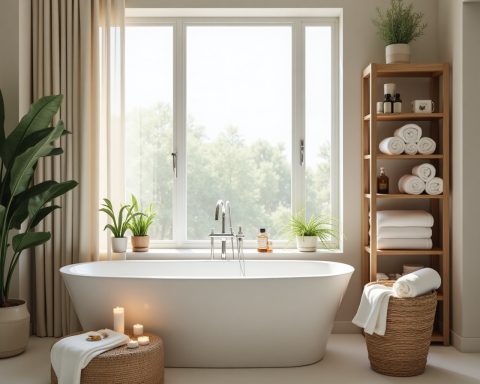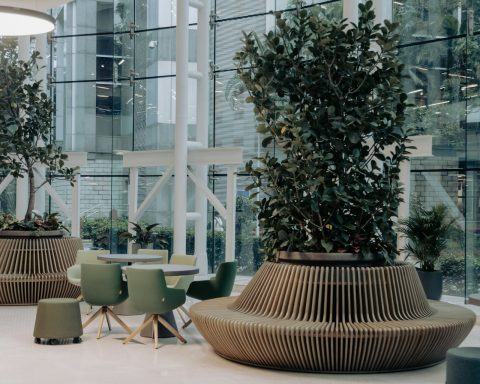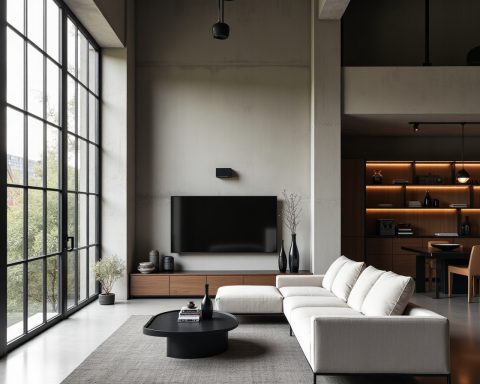Gothic interior design is a captivating aesthetic—bold, moody, and unapologetically dramatic. Drawing inspiration from the grandeur of medieval European architecture, Gothic style revels in rich, deep colors, intricate ornate details, cherished vintage touches, and an undeniably mysterious yet romantic ambiance. Whether your vision is a complete gothic transformation or the subtle introduction of its enchanting elements, this guide will empower you to create a space that feels both timeless and utterly spellbinding.
Here are 20+ Ways to Design a Gothic-Inspired Interior, complete with detailed ideas and essential styling tips for each:
1. Lay the Foundation with a Dark and Dramatic Color Palette
Gothic interiors flourish with deep, moody tones that inherently create a powerful sense of atmosphere.
- Embrace primary colors such as intense black, deep burgundy, rich forest green, luxurious plum, and profound navy.
- Introduce accents of antique gold, aged silver, or dark, character-rich wood for compelling contrast.
- Consider painting walls, ceilings, or even floors in these rich shades to cultivate a truly cocooning and immersive environment.
2. Select Ornate and Characterful Vintage Furniture
Furniture within a Gothic space should exude elegance, a sense of age, and a touch of grandeur.
- Seek out pieces featuring carved wood details, distinctive clawfoot legs, or plush tufted upholstery.
- Favor styles inspired by the Victorian, Baroque, or Rococo eras for their inherent drama and detail.
- Explore antique stores, estate sales, and vintage markets to uncover truly unique and characterful finds.
3. Indulge in Luxurious, Heavy Fabrics for Tactile Depth
Texture plays a pivotal role in Gothic interiors—think opulent and thoughtfully layered.
- Incorporate rich materials such as sumptuous velvet, intricate brocade, classic tapestry, smooth silk, or cozy faux fur.
- Consider floor-to-ceiling velvet drapes for dramatic flair or a truly enchanting canopy bed.
- Add throws and decorative pillows in these rich fabrics to soften any hard lines and enhance comfort.
4. Choose Gothic-Inspired Lighting Fixtures to Enhance the Mood
Lighting should serve to amplify the mysterious and inherently moody vibe of the space.
- Opt for striking wrought iron or elegant antique brass chandeliers and wall sconces.
- Explore candelabra-style light fixtures or vintage table lamps adorned with ornate shades.
- Incorporate dimmable lights or the soft glow of candles to create a warm and romantic ambiance.
5. Feature Striking Architectural Details (Or Cleverly Fake Them)
Gothic design is deeply rooted in the grandeur of medieval architecture.
- Introduce faux arches, elegant crown molding, or decorative ceiling medallions utilizing affordable peel-and-stick options.
- Utilize wallpaper featuring designs reminiscent of stone, brickwork, or intricate stained glass.
- Incorporate dramatic doors or window treatments that subtly echo cathedral-like elements.
6. Decorate with the Beauty of Stained Glass or Gothic Windows
Nothing quite embodies the Gothic aesthetic like the rich colors of stained glass and the elegant lines of pointed arches.
- Hang genuine stained glass panels in front of existing windows to diffuse light beautifully.
- Utilize budget-friendly adhesive stained-glass films to achieve a similar visual effect.
- Seek out mirrors or captivating wall art crafted in distinctive gothic window shapes.
7. Curate Symbolic and Intriguing Artwork
Art within a Gothic space should contribute to the overall mood of mystery, a touch of melancholy, or even spirituality.
- Hang striking portraits in ornate vintage frames, preferably in deep black or rich gold finishes.
- Favor artwork with medieval, mythological, or subtly occult-inspired themes.
- Consider creating DIY gothic gallery walls using thrifted frames painted in dark, cohesive tones.
8. Create a Dramatic Accent Wall with Wallpaper or Paint
Make a bold statement with captivating patterns or deeply textured finishes.
- Utilize wallpaper featuring classic damask, intricate baroque patterns, or moody floral gothic designs.
- Paint a single wall in a dramatic matte black or a deep, rich oxblood red for impactful contrast.
- Experiment with a faux stone or aged plaster finish to evoke the ambiance of a medieval castle.
9. Layer in the Warmth and Ambiance of Candles and Candelabras
Lighting is paramount in setting the desired mood—and the gentle flicker of candles excels at this.
- Use pillar candles in deep black, rich burgundy, or classic cream hues, arranged in striking groups.
- Display them on ornate candelabras, elegant wall sconces, or decorative trays.
- For safety without sacrificing the ambiance, consider using realistic flameless LED candles.
10. Introduce Gothic-Inspired Decor and Timeless Antiques
Details are crucial, and even small gothic-inspired pieces can have a significant impact.
- Display intriguing objects such as antique skulls, vintage hourglasses, decorative gargoyles, or aged keys.
- Utilize apothecary jars, mystical tarot decks, or elegant crystal displays to enhance the sense of mystery.
- Incorporate antique books or classic gothic literature in thoughtfully styled stacks.
11. Adorn Your Space with Dark and Moody Florals
Floral arrangements can seamlessly integrate into a gothic aesthetic when approached with the right sensibility.
- Choose deep red roses, dramatic black dahlias, or beautifully preserved dried arrangements.
- Utilize striking vases such as those crafted from black glass or antique silver.
- Consider draping florals with delicate lace or displaying them protectively under a glass dome.
12. Use Layered Rugs and Rich Textures Underfoot
Gothic interiors should envelop you in a sense of coziness, deep color, and decadent texture from floor to ceiling.
- Layer Persian or Oriental-style rugs to introduce richness and intricate patterns.
- Select rugs featuring deep, dark tones and elaborate, timeless designs.
- Incorporate faux fur throws or luxurious sheepskin rugs for added tactile contrast and comfort.
13. Install or Creatively Fake a Dramatic Fireplace Mantel
A gothic room often feels incomplete without the presence of a dark and ornate fireplace.
- Utilize a real, electric, or even a carefully chosen faux mantelpiece as a captivating focal point.
- Decorate the mantel with candles, antique picture frames, and artfully arranged dried roses.
- Consider painting the mantel a deep black and adding gothic-inspired scrollwork details for enhanced drama.
14. Hang Heavy, Luxurious Curtains or Impressive Tapestries
This adds significant texture and evokes an old-world, almost castle-like atmosphere.
- Choose rich velvet or intricate damask curtains that allow for a slight pooling effect on the floor.
- Hang medieval-style tapestries on large, prominent walls to introduce historical visual interest.
- Layer sheer curtains with blackout drapes to achieve both aesthetic beauty and practical light control.
15. Skillfully Mix in Gothic Revival and Victorian Elements
Blend these historically resonant styles to achieve the full and nuanced gothic effect you desire.
- Look for furniture featuring elegant curves, high-back chairs with character, and classic clawfoot tubs.
- Incorporate architectural salvage pieces such as decorative corbels or stately columns.
- Layer in delicate lace, elegant fringe, or sophisticated tassels for an added touch of vintage charm.
16. Incorporate the Warmth and Depth of Dark Wood Finishes
Wood introduces a sense of warmth, profound depth, and a tangible connection to history.
- Choose furniture crafted from rich mahogany, deep walnut, or dramatic ebony-toned woods.
- Utilize reclaimed wood shelves or headboards that showcase unique character and grain.
- Avoid overly modern wood finishes that might feel too light or sleek for a traditional gothic aesthetic.
17. Don’t Overlook the Dramatic Potential of the Ceiling
Gothic design embraces verticality—ensure your ceiling contributes to the overall atmosphere.
- Consider painting the ceiling in a darker shade than your walls to create a more intimate feel.
- Add faux wooden beams or even metallic star decals for a subtle celestial effect.
- Install a dramatic ceiling medallion or an eye-catching chandelier as a focal point.
18. Infuse a Sense of Intrigue, Mystery, and Fantasy
Gothic design often subtly flirts with themes of fantasy, the beauty of darkness, and a touch of enchantment.
- Introduce intriguing “witchy” elements such as elegant crystal balls, antique-style mirrors, or vintage potion bottles.
- Utilize dark poetry or framed Latin text as unique and evocative wall art.
- Incorporate antique clocks, intriguing shadow boxes, or mythological statues.
19. Utilize Black as a Sophisticated Neutral Foundation
In gothic interiors, black transcends being merely a color—it serves as a fundamental base upon which to build.
- Consider matte black walls, cabinets, or trim to establish a strong and dramatic tone.
- Pair black with the warmth of brass, the richness of gold, or the depth of dark wood.
- Allow other deep, jewel-toned colors (like plum, emerald green, or deep navy) to beautifully complement the black foundation.
20. Create a Cozy Reading Nook or a Gothic-Inspired Study
What could be more fitting for a gothic home than a moody corner dedicated to the pleasure of reading?
- Arrange a comfortable vintage armchair, a stylish floor lamp, and a small side table to create an inviting setup.
- Install built-in shelves or floating ledges to house your cherished collection of gothic literature.
- Decorate the space with atmospheric elements such as antique skulls, vintage hourglasses, or elegant quills.
21. Introduce Elements of Nature or the Subtly Occult
Gothic design often incorporates intriguing references to the cycles of life and death, and sometimes, the supernatural.
- Display carefully dried flowers, delicate feathers, ethically sourced bones, or interesting branches.
- Incorporate subtle astrology elements, such as depictions of moon phases, or antique-style spirit boards.
- Utilize black or antique-style terrariums filled with lush moss and intriguing crystals.
Final Thoughts:Crafting a Home That is Dark, Dreamy, and Deeply Reflective of You
Gothic interior design transcends mere dark colors—it is about cultivating a specific atmosphere, evoking a particular mood, and telling a unique story within your home. Whether you embrace a full gothic mansion aesthetic or simply weave in subtle touches of its allure, each carefully chosen element should contribute to a space that feels profoundly dramatic, deeply meaningful, and imbued with a touch of undeniable magic.
